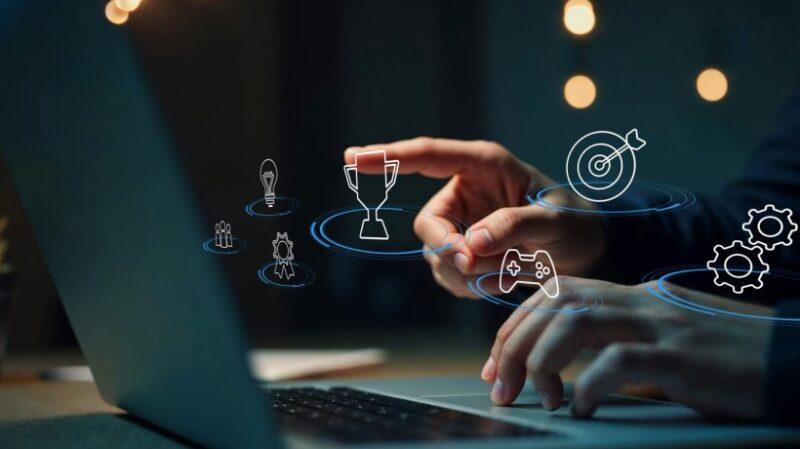
Implement gamified learning
Traditional corporate training is usually very cumbersome. Long slides, required modules, and standard courses typically discourage employees from reading through them. Meanwhile, gamifying the learning process can turn boring employee training into an engaging and interactive experience. Gamified employee training programs with game-like elements such as points, levels, badges, and challenges not only change the atmosphere of training sessions, but also energize participants and encourage them to approach it like a game rather than a job. In this article, we’ll take a deep dive into why gamified learning is more than just a fad, it’s here to stay, its impact on business outcomes, and practical strategies for successful implementation.
Why traditional training is often not enough
Even the most perfectly designed study program may not produce the desired results. Common issues organizations face include:
low motivation
Employees perceive training programs as mere formalities completed solely to satisfy management, rather than as a real way to learn new skills. General content
Standardized modules do not take into account individual learning styles or learning speeds. late feedback
Without immediate feedback, new knowledge is quickly forgotten. Weak link to business results
If learners cannot see a clear connection between the training content and their work, their engagement will be weakened.
Why is gamified learning important?
Here are some of the benefits of gamified learning:
Increased engagement and motivation
Gamified training consistently delivers higher engagement compared to traditional learning. Research shows that most employees feel more motivated when participating in gamified training compared to traditional programs, which tend to lag motivation. Improve knowledge retention and performance
Just-in-time feedback, leveling effects, and challenges help employees retain knowledge for longer periods of time. Direct business impact
Social gamified learning connects employee perspectives with measurable business outcomes such as sales, compliance, customer satisfaction, and innovation culture. These are more than just numbers. These show that gamified learning is not only a source of engagement, but also a strategic weapon.
How to successfully implement gamified learning
Here’s the roadmap that L&D teams must follow to make gamified learning work.
1. Align with business goals
Let’s start by defining what success looks like. Whether it’s increased sales, a safer workplace, or better customer service, make sure the gamification elements you choose directly support these outcomes.
2. Layers of game mechanics
Introduce a progression system where participants gain experience points and levels. Additionally, challenges in the form of scenario-based quests can be introduced. Badges and rewards are provided as you complete activities and reach goals.
Additionally, leaderboards provide a friendly way to compete. Provides real-time performance feedback. Use storytelling to help understand the context and importance of your training materials. Balance extrinsic rewards and intrinsic motivation.
3. Include realistic simulations
Give your employees the opportunity to experience a variety of work scenarios that might be risky in real life, but aren’t actually harmful, such as dealing with a difficult customer, responding to a safety incident, or making important business decisions. Mordor Intelligence states in its report that the global gamification market will reach $92.51 billion by 2030, highlighting the increasing importance of using gamification in business strategic planning. [1].
4. Personalize your experience
Give learners the freedom to choose their own learning path, overcome challenges at their own speed, and receive helpful feedback. Customized learning experiences help keep learners motivated and engaged.
5. Connect gamification to culture
Celebrate accomplishments through internal recognition, leaderboards, or badges that are visible to colleagues and managers. Active leadership involvement further enhances results.
6. Measure and iterate
Measure engagement, learning, behavior change, and business outcomes. Collect data and adjust aspects of gamification to keep the learning process fresh and engaging.
Looking to the future: future trends in implementing gamified learning
According to a report from Open Loyalty, gamification is leading loyalty investment priorities in 2025, with 45% of loyalty professionals identifying gamification as the most influential trend over the next two to three years, ahead of automation (40%) and partner-based marketing (33%). Future trends in gamified learning are very promising, including:
Augmented Reality (XR) + Gamification
Training in an immersive AR/VR environment. AI-driven adaptive learning
Real-time personalization based on performance and behavior. Social and cooperative gamification
Team-based quests, peer challenges, and knowledge sharing. continuous learning
In addition to formal training, gaming elements are also incorporated into daily work. Cross-platform digital credentials
Gamified achievements that employees can display internally and externally.
conclusion
Gamified learning transforms the training process from a boring experience to an engaging, motivating, goal-driven journey. Are you ready to improve the effectiveness and engagement of your employee training? Contact us to improve your training programs and drive meaningful business impact with gamified learning.
reference:
[1] Gamification market analysis
First published on: www.infoprolearning.com
Source link


